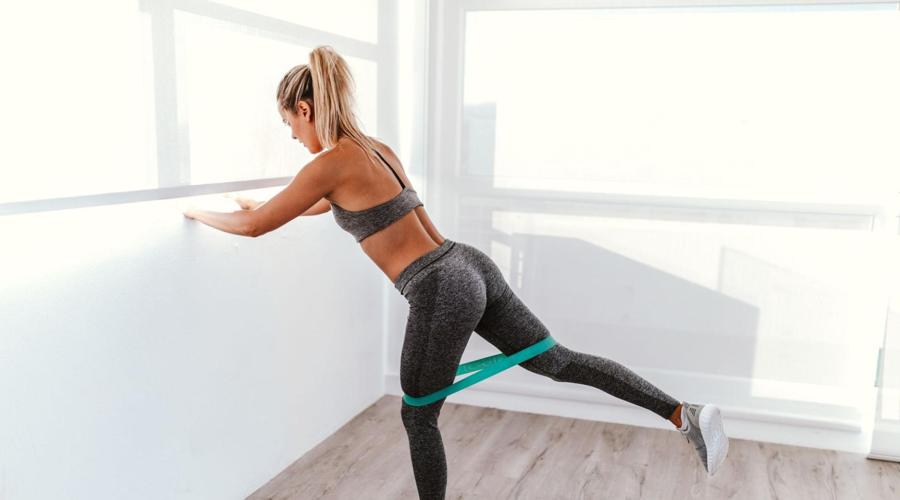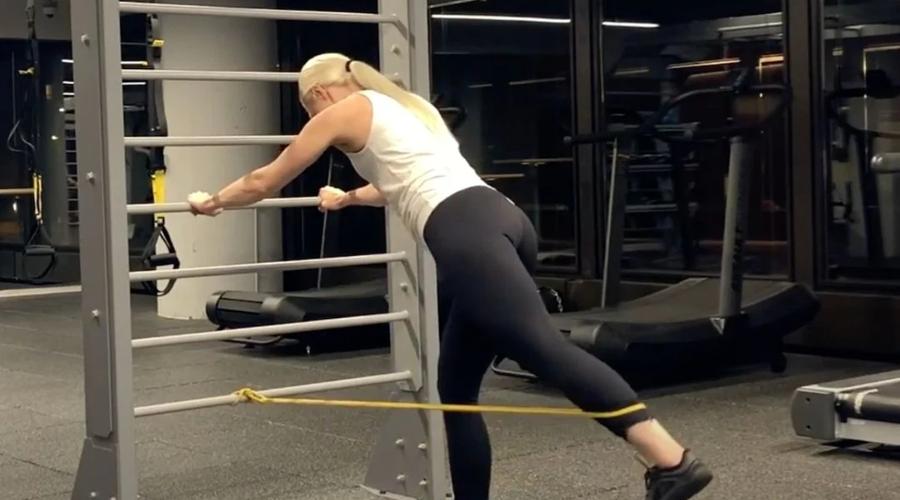Standing kickback lunges are a great exercise for targeting your glutes, hamstrings, and quads.
Here’s a complete guide to mastering this exercise:
Start by standing with your feet shoulder-width apart and your hands on your hips.
Take a step back with your left leg, and place the ball of your left foot on the ground.
Keep your weight evenly distributed between your left and right feet, and make sure your hips are square to the front.
As you inhale, bend your right knee and lower your body down into a lunge position. Your right knee should be directly above your ankle, and your left leg should be straight.
As you exhale, engage your glutes and push off the ground with your left foot, lifting your leg behind you as high as you can.
Keep your core tight and your back straight as you lift your leg, and avoid arching your back or leaning forward.
Hold for a moment at the top of the movement, squeezing your glutes, and then slowly lower your leg back down to the ground.
Repeat for a set number of reps on one side, and then switch sides.
Tips for Proper Form:
Keep your weight evenly distributed between your feet, and avoid leaning forward or back.
Keep your core engaged throughout the movement to support your back.
Focus on squeezing your glutes at the top of the movement to maximize the benefits for your butt.
Avoid arching your back or allowing your knee to extend beyond your toes during the lunge portion of the exercise.
Start with a small range of motion, and gradually increase the height of your kickback as your strength and flexibility improve.
Incorporating Standing Kickback Lunges into Your Workout:
Standing kickback lunges can be done as a standalone exercise or incorporated into a larger lower body workout. Try adding them to your routine two to three times a week, starting with 3 sets of 10 reps on each leg and gradually increasing the number of reps or sets as your strength improves.
What Are Standing Kickback Lunges
Standing kickback lunges are a type of exercise that targets your glutes, hamstrings, and quads. To perform the exercise, you start by standing with your feet shoulder-width apart and taking a step back with one leg, placing the ball of your foot on the ground.
You then bend your other leg into a lunge position, with your knee directly above your ankle, and push off the ground with your back foot, lifting it behind you as high as you can.
The movement involves kicking your back leg behind you while keeping your core tight and your back straight. You then lower your leg back down to the ground and repeat the movement for a set number of reps on one side before switching to the other leg.
Standing kickback lunges are a lower body exercise that targets your glutes, hamstrings, and quads. They are performed by stepping back into a lunge position and then lifting your back leg behind you, squeezing your glutes at the top of the movement.
This exercise requires balance and stability, as well as strength in your lower body muscles. It can be done with bodyweight or with added resistance, such as dumbbells or resistance bands.
What Equipment Need For Standing Kickback Lunges
Standing kickback lunges can be done with just your body weight, so no equipment is necessary. However, if you want to add resistance and increase the challenge, you can use dumbbells or resistance bands.
Dumbbells can be held in each hand or held at your sides, while resistance bands can be anchored to a stable object behind you or wrapped around your ankles. Additionally, you may want to use a yoga mat or other padded surface to protect your knees and provide better grip for your feet.
Standing kickback lunges can be performed with or without equipment. Here are some options:
Bodyweight: You can perform standing kickback lunges using just your bodyweight, making them a convenient exercise to do anywhere, anytime.
Dumbbells: You can hold dumbbells in your hands to add resistance to the exercise and make it more challenging.
Resistance bands: You can attach a resistance band around your ankles to increase resistance during the kickback portion of the exercise.
Smith machine: If you have access to a Smith machine, you can perform standing kickback lunges using the bar for added stability and resistance.
Overall, the equipment needed for standing kickback lunges depends on your preference and fitness level.

How Are Standing Kickback Lunges Effective For Toning The Glutes And Hamstrings
Standing kickback lunges are an effective exercise for toning the glutes and hamstrings because they target these muscle groups directly. Here are some reasons why:
- Glute activation: The glutes are the primary muscle group targeted during the kickback portion of the exercise. By squeezing your glutes at the top of the movement, you’re activating these muscles and helping to tone and shape them over time.
- Hamstring activation: The hamstrings are also worked during standing kickback lunges, particularly during the lunge portion of the exercise. As you lower your body down into the lunge position, your hamstrings are engaged to help stabilize your body and support your movement.
- Compound movement: Standing kickback lunges are a compound movement, meaning they work multiple muscle groups at once. This makes them an efficient exercise for toning the glutes and hamstrings, as well as other lower body muscles like the quads and calves.
- Progressive overload: To continue seeing results from standing kickback lunges, you can gradually increase the resistance or reps over time. This progressive overload helps to challenge your muscles and stimulate growth, leading to toned and stronger glutes and hamstrings.
Overall, standing kickback lunges are an effective exercise for toning the glutes and hamstrings because they activate these muscles directly, work multiple muscle groups at once, and can be progressed over time for continued results.
How Perform Standing Kickback Lunges
Here’s how to perform standing kickback lunges:
- Begin standing with your feet shoulder-width apart and your hands on your hips.
- Take a step back with your left foot, placing the ball of your foot on the ground.
- Keep your weight evenly distributed between both feet and make sure your hips are facing forward.
- As you inhale, bend your right knee and lower your body down into a lunge position. Your right knee should be directly above your ankle, and your left leg should be straight.
- As you exhale, engage your glutes and push off the ground with your left foot, lifting your leg behind you as high as you can.
- Keep your core tight and your back straight as you lift your leg, and avoid arching your back or leaning forward.
- Hold for a moment at the top of the movement, squeezing your glutes.
- Slowly lower your left leg back down to the ground and repeat for the desired number of reps.
- Switch sides and repeat the exercise with your right leg.
Here are a few tips for performing standing kickback lunges:
- Keep your weight evenly distributed between both feet throughout the exercise.
- Keep your core engaged throughout the movement to support your back.
- Focus on squeezing your glutes at the top of the movement to maximize the benefits for your butt.
- Avoid arching your back or allowing your knee to extend beyond your toes during the lunge portion of the exercise.
- Start with a small range of motion, and gradually increase the height of your kickback as your strength and flexibility improve.
How Many Reps And Sets Of Standing Kickback Lunges Should Do
The number of reps and sets of standing kickback lunges you should do depends on your fitness level and goals. Here are some general guidelines:
Beginners: If you’re new to standing kickback lunges or strength training in general, start with 2-3 sets of 10-12 reps on each leg.
Intermediate: If you’ve been strength training for a while and are comfortable with standing kickback lunges, aim for 3-4 sets of 12-15 reps on each leg.
Advanced: If you’re experienced with strength training and looking for a challenge, aim for 4-5 sets of 15-20 reps on each leg.
Remember to focus on proper form and technique, rather than rushing through your reps or sets. Rest for 30-60 seconds between sets, and increase the resistance or reps gradually over time to continue challenging your muscles and seeing results.

How Can Standing Kickback Lunges Be Modified For Beginners
Standing kickback lunges can be modified for beginners by reducing the range of motion and/or performing the exercise without added weight. Here are some modifications to consider:
Reduce the range of motion: Instead of lowering your body all the way down into a lunge position, only go part of the way down to reduce the difficulty of the exercise. This can help you focus on proper form and technique before advancing to a full range of motion.
Use a chair or wall for support: If you have trouble with balance or stability, you can use a chair or wall for support while performing the exercise.
Perform the exercise without weight: You can start with just your bodyweight for resistance and gradually increase the difficulty by adding weight over time.
Break the exercise into two parts: You can start by practicing the lunge portion of the exercise first, and then adding the kickback once you feel comfortable with the movement.
Remember to listen to your body and make modifications as needed to avoid injury. As you gain strength and confidence, you can gradually increase the difficulty of the exercise by increasing the range of motion, adding weight, or performing more reps and sets.
What Are Some Common Mistakes To Avoid When Doing Standing Kickback Lunges
Here are some common mistakes to avoid when doing standing kickback lunges:
Allowing your knee to go beyond your toes:
When you’re in the lunge position, make sure your front knee does not extend beyond your toes. This can put unnecessary stress on your knee and potentially cause injury.
Leaning too far forward:
Keep your torso upright and avoid leaning too far forward during the exercise. This can cause you to lose balance and potentially strain your lower back.
Arching your back:
Maintain a neutral spine throughout the exercise, and avoid arching your back. This can also cause lower back strain and lead to improper form.
Not engaging your glutes:
The kickback portion of the exercise is meant to target your glutes, so make sure you’re squeezing your glutes at the top of the movement. This will ensure you’re getting the most out of the exercise and effectively toning your butt muscles.
Lifting your leg too high:
While it’s important to lift your leg behind you to engage your glutes, avoid lifting it higher than your hip level. Lifting it too high can put unnecessary strain on your lower back and potentially cause injury.
Rushing through the exercise:
It’s important to maintain proper form and technique throughout the exercise, rather than rushing through the reps. This will ensure you’re engaging the right muscles and avoiding injury.
By avoiding these common mistakes, you can perform standing kickback lunges safely and effectively to tone your glutes, hamstrings, and quads.
What Are Some Variations Of Standing Kickback Lunges
There are several variations of standing kickback lunges that you can try to add variety to your workout and target different muscle groups. Here are some options:
Curtsy lunges with kickback:
Instead of stepping directly back into a lunge, step back and to the side at a diagonal angle, crossing one foot behind the other. Lower into a curtsy lunge, and then lift your back leg into a kickback.
Reverse lunges with kickback:
Instead of stepping back with one foot, step back with both feet to perform a reverse lunge. From there, lift your back leg into a kickback.
Side lunges with kickback:
Step out to the side with one foot, keeping the other foot planted on the ground. Lower into a side lunge, and then lift your back leg into a kickback.
Weighted kickbacks:
Hold a dumbbell or kettlebell in the hand opposite your working leg to add resistance to the kickback portion of the exercise.
Resistance band kickbacks:
Attach a resistance band around your ankles to increase resistance during the kickback portion of the exercise.
Remember to maintain proper form and technique during any variation of standing kickback lunges, and to listen to your body to avoid injury. Incorporating variations can help keep your workouts interesting and challenging while targeting different muscle groups.

How Can Standing Kickback Lunges Help With Weight Loss
Standing kickback lunges can be modified for beginners by reducing the range of motion and/or performing the exercise without added weight. Here are some modifications to consider:
Reduce the range of motion: Instead of lowering your body all the way down into a lunge position, only go part of the way down to reduce the difficulty of the exercise. This can help you focus on proper form and technique before advancing to a full range of motion.
Use a chair or wall for support: If you have trouble with balance or stability, you can use a chair or wall for support while performing the exercise.
Perform the exercise without weight: You can start with just your bodyweight for resistance and gradually increase the difficulty by adding weight over time.
Break the exercise into two parts: You can start by practicing the lunge portion of the exercise first, and then adding the kickback once you feel comfortable with the movement.
Remember to listen to your body and make modifications as needed to avoid injury. As you gain strength and confidence, you can gradually increase the difficulty of the exercise by increasing the range of motion, adding weight, or performing more reps and sets.
How Standing Kickback Lunges Suitable For People With Knee Problems
Standing kickback lunges may not be suitable for people with knee problems, as they can put stress on the knee joint. However, there are modifications and alternative exercises that can be done to reduce stress on the knee while still targeting the glutes, hamstrings, and quads. Here are some options:
Mini squats: Stand with your feet shoulder-width apart, and lower your body down into a mini squat. Keep your weight evenly distributed between both feet, and avoid letting your knees go beyond your toes. Hold for a moment, and then push back up to a standing position. Repeat for desired reps.
Glute bridges: Lie on your back with your knees bent and feet flat on the ground. Lift your hips up toward the ceiling, squeezing your glutes at the top of the movement. Lower back down to the ground and repeat for desired reps.
Clamshells: Lie on your side with your knees bent and your feet together. Lift your top knee as high as you can while keeping your feet together. Lower back down and repeat for desired reps.
Seated leg lifts: Sit in a chair with your feet flat on the ground. Lift one leg up as high as you can, squeezing your glutes at the top of the movement. Lower back down and repeat for desired reps.
Remember to always listen to your body and speak with a healthcare professional before starting any new exercise program, especially if you have knee problems.
How Often Should Do Standing Kickback Lunges
How often you should do standing kickback lunges depends on your fitness level and goals. In general, it’s recommended to aim for at least 2-3 lower body workouts per week that incorporate exercises like standing kickback lunges. Here are some guidelines:
Beginners: If you’re new to standing kickback lunges or strength training in general, start with 2-3 sets of 10-12 reps on each leg, 2-3 times per week.
Intermediate: If you’ve been strength training for a while and are comfortable with standing kickback lunges, aim for 3-4 sets of 12-15 reps on each leg, 2-3 times per week.
Advanced: If you’re experienced with strength training and looking for a challenge, aim for 4-5 sets of 15-20 reps on each leg, 2-3 times per week.
Remember, it’s important to listen to your body and allow for adequate rest and recovery between workouts. It’s also important to vary your workouts and target different muscle groups to avoid overuse injuries and see the best results. Incorporating a variety of exercises and workout styles into your routine, including cardio and flexibility training, can help you achieve your fitness goals and maintain overall health and wellness.

Conclusion
In conclusion, standing kickback lunges are a great lower body exercise that can help tone and strengthen the glutes, hamstrings, and quads. They can be done with or without equipment and can be modified for beginners or advanced fitness levels.
To perform the exercise correctly, make sure to focus on proper form and technique, engage your glutes at the top of the movement, and avoid common mistakes like arching your back or leaning too far forward. Incorporating standing kickback lunges into your fitness routine, along with a healthy diet and overall lifestyle habits, can help support weight loss, improve cardiovascular health, and improve body composition.
As with any exercise program, it’s important to listen to your body, seek medical advice if needed, and allow for adequate rest and recovery between workouts.
Can I do standing kickback lunges as a warm-up exercise?
Yes, standing kickback lunges can be included as part of your warm-up routine before more intense exercises.
Is it normal to feel sore after doing standing kickback lunges?
Yes, it’s normal to feel some soreness in your glutes and hamstrings after doing standing kickback lunges. It’s a sign that your muscles are adapting and getting stronger.
Can standing kickback lunges be included in a full-body workout?
Yes, standing kickback lunges can be included as part of a full-body workout routine.
How long does it take to see results from standing kickback lunges?
Results can vary depending on various factors, such as your fitness level, diet, and consistency. With consistent practice, you may start to see results in as little as 4-6 weeks.




